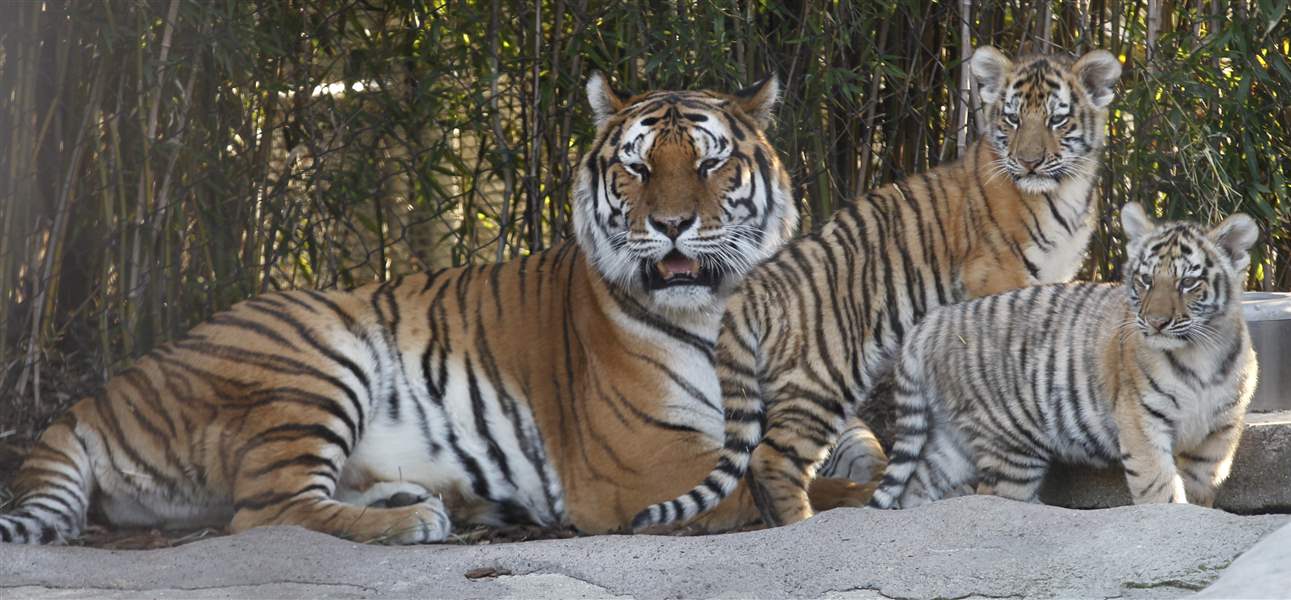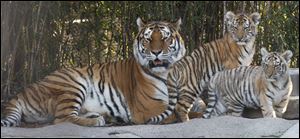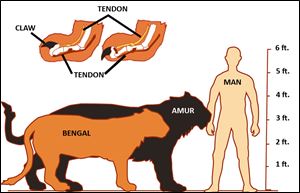
TOLEDO MAGAZINE
Russia home to last population of wild Amur tigers in the world
Two cubs born at Toledo Zoo in fall
2/26/2012
The Toledo Zoo has four Amur tigers with the addition of these two cubs born in September to mother Marta.
The Blade
Buy This Image

The Toledo Zoo has four Amur tigers with the addition of these two cubs born in September to mother Marta.
In the struggle to preserve and protect the precious few Amur tigers in the world, one of the safety deposit boxes securing that rare resource is here in Toledo, more than 6,000 miles from the tiger’s last established habitat in extreme eastern Russia.
The Toledo Zoo is a partner in the Amur tiger Species Survival Plan (SSP) in which a number of facilities engage in a collaborative effort to strengthen the Amur numbers in a healthy and genetically diverse manner.
PHOTO GALLERY: Maps, graphics, images
MARKEY COLUMN: Amur a star to behold
The zoo welcomed two tiger cubs in late September, a male and a female. They were born to Marta, a first-time mother, and fathered by Strannik, a male on loan from the Toronto Zoo, via the Erie Zoo.
After spending about three months with their mother in relative seclusion, the cubs went on exhibit at the zoo in late January. The cubs will remain with Marta, who was born at the Toledo Zoo in 2003, for up to two years.
Strannik, who was separated from Marta before the cubs were born to safeguard against potentially aggressive behavior towards her or the cubs, is on exhibit next to the cubs, Viktor and Talya, and their mother. At some point, Strannik will be moved to another zoo and likely bred with a different female.
The cubs, which weighed three or four pounds at birth, had grown to nearly 60 pounds at their last checkup. They are still nursing, but have also started to eat solid food.

There are an estimated 200-400 Amur tigers in the wid and about 150 in 53 zoos in the United States. There area eight subspecies of tigers, including the Amur and Bengal; three are extinct and the other five are listed as endangered.
Viktor and Talya, along with their parents, are a living insurance policy to protect against the loss of this great cat.
The Amur tiger once ranged across a wide area of Siberia, eastern Russia, northeastern China, and the Korean peninsula. These regions provided the vast forested landscapes the tigers needed to establish their territories and to find adequate prey to survive.
The tiger’s habitat has been destroyed in many areas by intensive logging operations, and the population further damaged by the fragmenting of habitat, which created small pockets of tigers and weakened their genetic diversity.
The tigers, sometimes called Siberian tigers but more accurately referred to as Amur tigers, also have long been victims of poaching, which historically fed a thriving illegal trade in tiger skins, bones, and body parts, which are used in some traditional Chinese medicinal practices. As logging expanded, poachers used logging trails to gain access to wilderness areas that previously had been extremely remote.
Wildlife watchdog groups estimated that in 1991 alone, possibly one-third of the Amur tiger population was killed to satisfy the demands of traditional Chinese medicine for tiger parts, although such practices are now illegal in China.
The survival of Amur tigers in the wild has been further threatened by the depleting populations of their primary prey — wild boar and several species of deer.
The Amur tiger gets its name from the Amur River that flows nearly 3,000 miles across Asia and forms a natural border between Russia and China.

Retractable claws are used to grip prey and scratch trees to mark territory. Amur tigers are the world's largest cats, even larger than their southern relative Bengal tigers.
AMUR TIGER FACTS:
• Can pounce three times its body length when attacking prey.
• Must survive eastern Siberia where rivers stay frozen up to eight months a year and temperatures may drop to 58 below zero.
• Eats as much as 90 pounds of meat in a single meal.
• Hunt primarily wild boar and deer but also will eat other small mammals and fish.
• Capable of dragging prey that would take more than a dozen men to move.
• Travels long distances in search of prey; in one documented case, 622 miles in 22 days.
• Are solitary hunters that use stealth and attack from behind.
• Have top and bottom tendons that work together to to protract and retract claws, which are pulled in during walking to keep the claws sharp and the tiger silent.
• Reach a length of 9-12 feet from head to tip of tale (adult males) and stand 3.5 feet at the shoulder.
• Weigh 400-650 pounds, with a heaviest recorded weight at 850 pounds.
Sources: IMP Wildlife, National Geographic
Contact Matt Markey at: mmarkey@theblade.com or 419-724-6068.